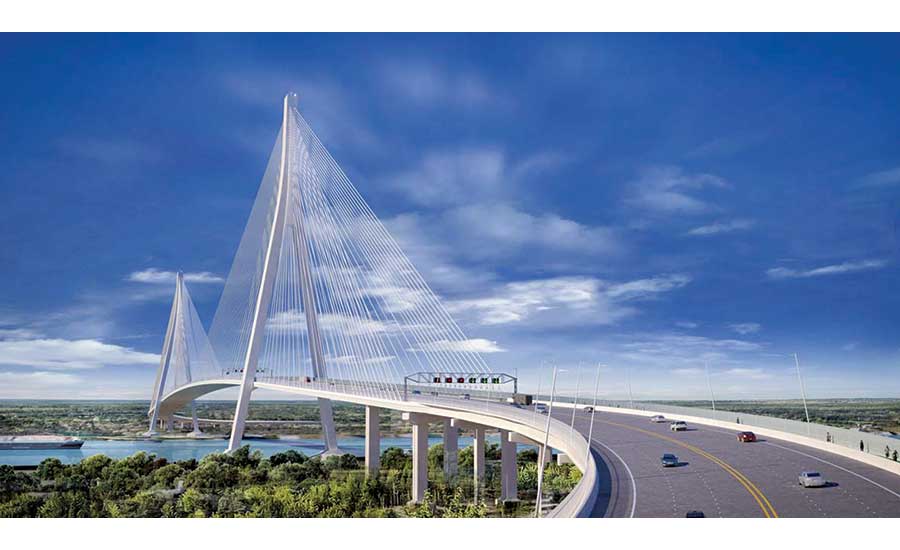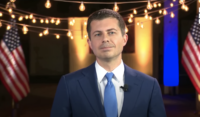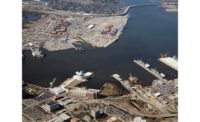A controversial new international border crossing between Detroit and Windsor, Ontario, appears finally ready to move forward, with the July 5 selection of the design-build team set to begin major work on the public-private partnership (P3) project in September.
The Windsor-Detroit Bridge Authority, a Canadian government corporation, tapped the consortium to build the Gordie Howe International Bridge, which was repeatedly stymied by legal challenges from private owners of a nearby bridge but could still factor into brewing U.S.-Canada trade tensions.
Key members of the team are ACS Infrastructure Canada Inc.; Dragados Canada Inc.; Fluor Canada Ltd.; AECOM; RBC Dominion Securities Inc.; Turner Construction, Carlos Fernandez Casado S.L/FHECOR Ingenieros Consultores, S.A.; Moriyama and Teshima Architects; and Smith-Miller + Hawkinson Architects, according to the bridge agency announcement and media reports.
The consortium, Bridging North America, will design, build and finance the 1.5-mile cable-stay bridge across the Detroit River and provide maintenance for 30 years following planned completion in 2023.
It will feature an 853-meter main span, the longest of its type in North America.
Canada contractor Aecon Group Inc. had been part of the team initially but exited in May amid a federal review of its proposed takeover by a Chinese state-owned company that the Canadian government ultimately blocked.
Two other bid teams were in contention—one that included SNC-Lavalin Group Inc., VINCI, American Bridge Co., HDR and Alfred Benesch & Co., and the other with Bechtel, EllisDon Civil Ltd., an Arup-Hatch-Mott McDonald joint venture and Traylor Bros. Inc.
The P3 arrangement also includes new port-of-entry facilities on both sides of the border and a new link with I-75 in Detroit.
Details on the project’s total cost and schedule will not be released until financial close in September, but previous estimates range from $2.1 billion to $4.5 billion.
The authority has overseen more than $266 million worth of utility relocations and other site work at both port of entry sites. In March, it signed Parsons Corp. to a $46.4-million contract as owner’s representative.
Named for the Canadian ice hockey legend, the new bridge has been touted as a needed alternative to the 89-year-old Ambassador Bridge that regularly bogs down under 2.6 million annual truck crossings.
Despite receiving Canadian government permission last year to build a parallel structure, the U.S.-based Moroun family has vigorously fought the Gordie Howe project in state and federal lawsuits. The Michigan Court of Appeals rejected its latest challenge in May, but the family and state officials are still battling eminent domain issues on key land parcels.
The Morouns have asked President Donald Trump to cancel Gordie Howe’s federal permits, claiming in targeted television ads that it will be a mainly Canadian venture, and will use steel imported from overseas. A bridge agency official says the completed bridge will be owned by Canada and Michigan. A 2012 pact also mandates use of U.S. or Canadian materials for the bridge and U.S. port-of-entry plaza.
The Morouns also want Trump to halt the demolition of their bridge, required in the Canadian permit for the parallel span.
The Gordie Howe project also has had internal challenges, including a protracted P3 process that pushed its likely completion past the original estimated 2020 timeframe and contributed to the departure last year of then-CEO Michael Cautillo.
Named on June 26 to replace him is Bryce Phillips, vice president of Toronto infrastructure consultant Kinectrics and a former AMEC executive with experience in running two Canadian nuclear plants.






Post a comment to this article
Report Abusive Comment